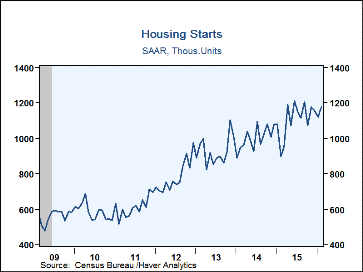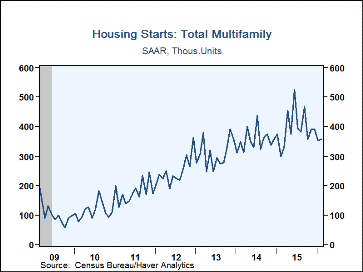 Global| Mar 16 2016
Global| Mar 16 2016Housing Starts Rebound in February, But Permits Fall
by:Sandy Batten
|in:Economy in Brief
Summary
Housing starts jumped up 5.2% (30.9% y/y) in February to 1.178 million units at an annual rate. There were also upward revisions to both December and January figures, months in which starts had fallen. The February reading exceeded [...]
Housing starts jumped up 5.2% (30.9% y/y) in February to 1.178 million units at an annual rate. There were also upward revisions to both December and January figures, months in which starts had fallen. The February reading exceeded the 1.150 million expectation from the Action Economics Forecast Survey.
Single-family starts led the February increase, rising 7.2% m/m (37.0% y/y) to 822,000 units (AR) after having declined in both January and December. This is the highest level of single-family starts since November 2007. In contrast, multi-family starts only edged up 0.8% m/m (18.7% y/y) to 356,000 units in February, reflecting weakness in starts of 2-4 unit structures, following a sharp 9.5% m/m drop in January.
By region, starts plummeted in the Northeast, plunging 51.3% m/m to 73,000 units (AR), the lowest level since last February. Starts rose in each of the other three regions. They jumped 19.9% m/m in the Midwest to 181,000 units (AR), the first increase in four months. Starts in the South rose 7.1% m/m to 615,000 units (AR), following two consecutive monthly declines. And in the West, starts jumped 26.1% m/m to 309,000 units (AR), their largest monthly increase since April 2015.
Building permits in February did not exhibit the same rebound as did starts. Permits slumped 3.1% m/m to 1.167 million (AR) from 1.204 million in January. Permits have not risen since last November. However, compared to a year ago, permits were still up 6.3%. The February decline was isolated in multi-family permits, which slumped 8.4% m/m to 436,000. Single-family permits edged up 0.4% m/m to 731,000.
The housing starts and permits figures can be found in Haver's USECON database. The expectations figure is contained in the AS1REPNA database.
| Housing Starts (000s, SAAR) | Feb | Jan | Dec | Feb Y/Y % | 2015 | 2014 | 2013 |
|---|---|---|---|---|---|---|---|
| Total | 1,178 | 1,120 | 1,159 | 30.9 | 1,107 | 1,001 | 928 |
| Single-Family | 822 | 767 | 769 | 37.0 | 713 | 648 | 618 |
| Multi-Family | 356 | 353 | 390 | 18.7 | 395 | 356 | 307 |
| Starts By Region | |||||||
| Northeast | 73 | 150 | 155 | 58.7 | 136 | 110 | 97 |
| Midwest | 181 | 151 | 165 | 77.5 | 151 | 163 | 150 |
| South | 615 | 574 | 588 | 20.8 | 555 | 496 | 464 |
| West | 309 | 245 | 251 | 27.2 | 265 | 235 | 215 |
| Building Permits | 1,167 | 1,204 | 1,204 | 6.3 | 1,164 | 1,052 | 991 |
Sandy Batten
AuthorMore in Author Profile »Sandy Batten has more than 30 years of experience analyzing industrial economies and financial markets and a wide range of experience across the financial services sector, government, and academia. Before joining Haver Analytics, Sandy was a Vice President and Senior Economist at Citibank; Senior Credit Market Analyst at CDC Investment Management, Managing Director at Bear Stearns, and Executive Director at JPMorgan. In 2008, Sandy was named the most accurate US forecaster by the National Association for Business Economics. He is a member of the New York Forecasters Club, NABE, and the American Economic Association. Prior to his time in the financial services sector, Sandy was a Research Officer at the Federal Reserve Bank of St. Louis, Senior Staff Economist on the President’s Council of Economic Advisors, Deputy Assistant Secretary for Economic Policy at the US Treasury, and Economist at the International Monetary Fund. Sandy has taught economics at St. Louis University, Denison University, and Muskingun College. He has published numerous peer-reviewed articles in a wide range of academic publications. He has a B.A. in economics from the University of Richmond and a M.A. and Ph.D. in economics from The Ohio State University.










